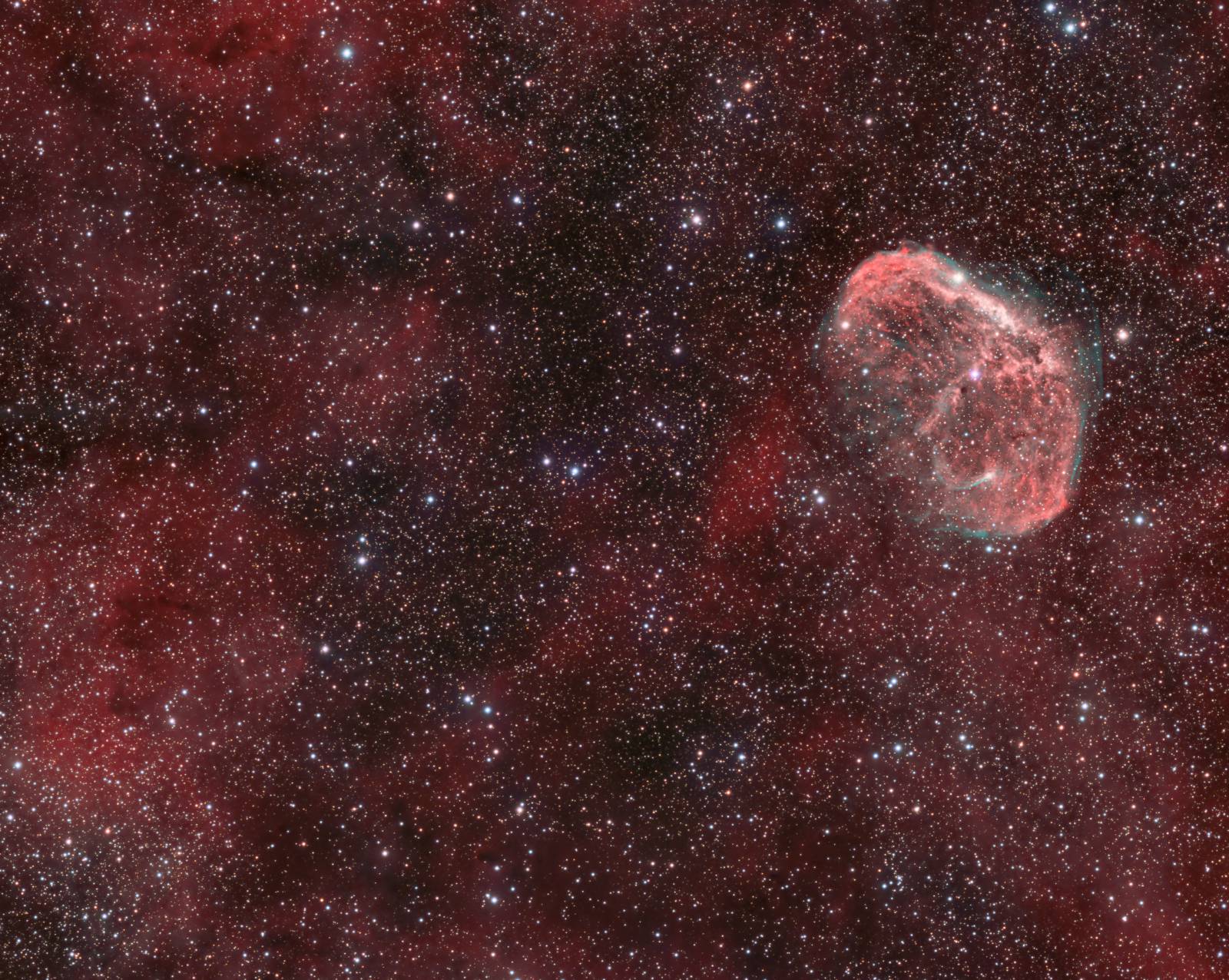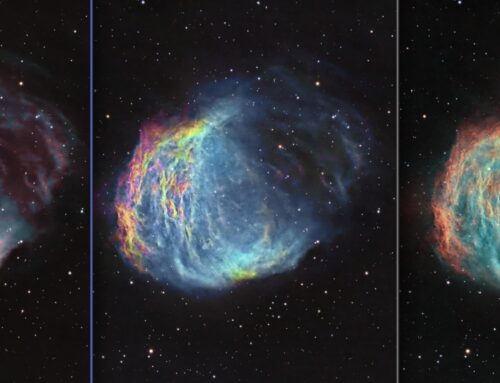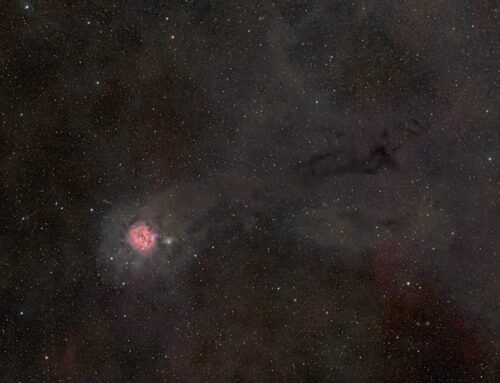The Crescent and Soap Bubble Nebulae

Click image for full size version
July 13, 2018
 The Crescent Nebula is an emission nebula situated about 5,000 light years away, and dominates the right side of this image. It lies in a patch of Milky Way that runs right through Cygnus, the Swan. The richness of the Milky Way in this region is apparent from the vast number of stars in this image. The red hues of the Crescent Nebula and the surrounding area is due mostly to glowing hydrogen gas; the teal comes from emissions of oxygen atoms. The Crescent Nebula is being energized and “blown out” by energetic winds coming from the powerful central star, WR136. The WR signifies that it is a “Wolf-Rayet” star — very hot, at least 20 times the mass of the sun, and losing mass rapidly. I read that WR136 is shedding the equivalent of the Sun’s mass every 10,000 years and that it will eventually explode in a supernova! That will probably produce another very interesting nebula for our descendants to look at!
The Crescent Nebula is an emission nebula situated about 5,000 light years away, and dominates the right side of this image. It lies in a patch of Milky Way that runs right through Cygnus, the Swan. The richness of the Milky Way in this region is apparent from the vast number of stars in this image. The red hues of the Crescent Nebula and the surrounding area is due mostly to glowing hydrogen gas; the teal comes from emissions of oxygen atoms. The Crescent Nebula is being energized and “blown out” by energetic winds coming from the powerful central star, WR136. The WR signifies that it is a “Wolf-Rayet” star — very hot, at least 20 times the mass of the sun, and losing mass rapidly. I read that WR136 is shedding the equivalent of the Sun’s mass every 10,000 years and that it will eventually explode in a supernova! That will probably produce another very interesting nebula for our descendants to look at!
But there is more in this image. Diagonally opposite the Crescent Nebula in the lower left portion of the image is a ghostly, perfectly round, red bubble. This is the Soap Bubble Nebula, discovered in 2007 by amateur astronomer Dave Jurasevich using a 160 mm refractor.
Tekkies:
Sky-Watcher Esprit 150 f/7 refractor, QHY 16200-A camera, Optolong Ha, O3, L, R, G and B filters, Paramount MX. Acquisition with TheSkyX unguided. Focused with FocusMax 4. Automation with CCDCommander. All pre-processing and processing in PixInsight. Acquired from my SkyShed in Guelph. No Moon, average to excellent transparency and fair to above average seeing. Data acquired June 16-26, 2018.
12x10m L, 10x10m R, 9x10m B and G, 32x10m Ha and 17x10m O3, unbinned frames (total=14hr50m).
Data Reduction and Cleanup
The BatchPreProcessing script was used to perform calibration, cosmetic correction and registration of all frames. ImageIntegration was used to make the Ha, O3, L, R, G and B masters. DynamicCrop was used to crop all the masters identically. DynamicBackgroundExtraction was applied to each master.
Synthetic Luminance
Creation and cleanup of SynthL: The L, R, G and B masters were combined using ImageIntegration (average, additive with scaling, noise evaluation, iterative K-sigma / biweight midvariance, no pixel rejection).
Deconvolution: A star mask was made to use as a local deringing support. A copy of the image was stretched to use as a range mask. Regularized Richardson-Lucy Deconvolution was applied (75 iterations, external PSF made using DynamicPSF tool with about 30 stars).
Linear Noise Reduction: MultiscaleLinearTransform was used to reduce noise in the SynthL image. An internal mask was used, with layer settings for threshold and strength as follows: Layer 1: 3, 0.7 Layer 2: 2, 0.5 Layer 3: 2, 0.45.
Stretching: HistogramTransformation, was applied to the SynthL to make a pleasing, bright image.
RGB Creation
Creation and cleanup: ChannelCombination was used to make color image from the R, G and B masters. The RGB image was processed with PhotometricColorCalibration using a small preview of background sky as the background reference.
Linear Noise Reduction: MultiscaleLinearTransform was used to reduce noise in the RGB image. An internal mask was used, with layer settings for threshold and strength as follows: Layer 1: 3, 0.75 Layer 2: 2, 0.6 Layer 3: 2, 0.5.
Stretching: HistogramTransformation, was applied to the RGB image to make a pleasing, bright image.
Ha and O3
Deconvolution of Ha: A star mask was made to use as a Local Deringing Support image. A copy of the image was stretched to use as a range mask. Deconvolution was applied (80 iterations, regularized Richardson-Lucy, external PSF made using DynamicPSF tool with about 20 stars).
Linear Noise Reduction: MultiscaleLinearTransform was used to reduce noise in the background areas of the Ha and O3 images. Layer settings for threshold and strength: Layer 1: 3.0 0.9 Layer 2: 2.0, 0.75 Layer 3: 1.0, 0.6 Layer 4: 0.5, 0.2.
Stretching: HistogramTransformation was applied to the Ha and O3 images with background brightness approximately matching the SynthL.
Combining SynthL, RGB, Ha and O3
SynthLRGB: The processed SynthL was applied to the RGB image using LRGBCombine.
SynthLHaO3RGB: PixelMath was used to add Ha to the red channel and O3 to the green and blue channels with the following expressions, using a mask to ensure smooth transitions.
Red: iif($T[0]<1.2*Ha, 1.35*Ha, $T[0])
Green: iif($T[1]<1.1*O3, 1.15*O3, $T[1])
Blue: iif($T[2]<1.1*O3, 1.15*O3, $T[2])
Additional Processing
Noise Reduction and Re-Stretch: TGVDenoise was applied in L*a*b* mode (1000 iterations with convergence on and set to 0.004) with a range mask used to protect high signal areas. HistogramTransformation was used to raise the black point (but with no clipping).
Sharpening: Using a mask to protect stars, background and dim nebulosity, MultiscaleLinearTransform was applied to sharpen layers 2 and 3 (bias of 0.1 and 0.2, respectively).
Final Steps: Background, nebula and star brightness, contrast and saturation were adjusted in several iterations using Curves with masks as required. The DarkStructureEnhance script was applied with default settings.
Image scale is about 1.15 arcsec per pixel for this camera/telescope combination.






Ron,while I do not understand all you do or how ,but I love seeing your work ( Photos). You have a great talent,thanks for sharing.
Ron H